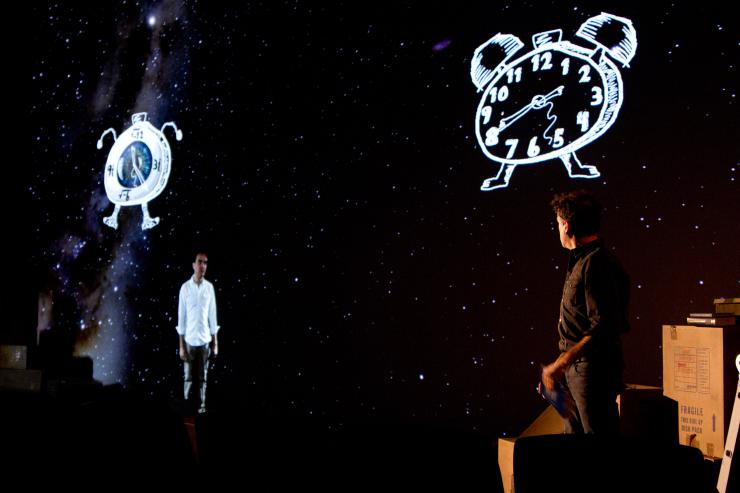Media Design in the Rehearsal Hall Part 1
This blog series offers a multi-disciplinary approach to achieve the best practices for collaboration in the creative and production process of incorporating digital media into live performance.
Is media another design element to be incorporated into production during tech week, or should it be present in the rehearsal hall? Like most answers, it depends on what you are doing. Not all types of media need be in the rehearsal hall. To help clarify, I suggest dividing media into two broad categories: atmospheric and interactive. How do we decide which category our media belongs?
Think of media as a prop, such as a sword. If the sword is worn on a belt as part of a costume, but the actor never draws the sword, it is not crucial to the actor’s performance to have that prop in rehearsal. Certainly it would be nice to have it on her belt, as it affects how she sits or moves, but she could pretend the sword is at her hip during rehearsal. If the sword is a priced possession of the Captain and it is prominently displayed on the wall center stage, the actor playing the Captain can be told where the sword is in physical space and simply refer to the imaginary sword during rehearsals. In both of these scenarios the sword would be atmospheric. It is not crucial to the actor’s performance to have the prop in rehearsal. It can and should be added in tech week.
However, if the sword is used by the actor to duel another actor, then the sword better be in rehearsal. The last thing we want is to arrive at tech week and hand an actor a sword she had never wielded. In fact, we would go through great lengths to integrate this sword into the production. There’d be extra time in rehearsal to properly train the performer on how to use the sword. We’d also have a fight choreographer, a fight captain, and fight calls. She’d learn what the sword can and cannot safely accomplish. This type of sword is interactive and should be present in the rehearsal hall.
Rehearsal is where performers get to know each other, so why don’t we tend to incorporate interactive media into rehearsals?
Atmospheric Media. This media is exactly like the atmospheric prop because the actor doesn’t need to actively engage with it. For instance, content playing on a television underscoring a scene. Or it could be projections of the forest for a scene in the woods. As long as the actor only refers to the media, it creates mood, or enhances the scenography, and then it can be placed in this category and isn’t needed until tech week.
Interactive Media. Like the interactive sword, interactive media is something that the actor needs in order to perform. For example, the interactive media can be a live video capture of another performer, or a digital avatar the performer converses with or controls. Interactive media is also any kind of motion capture where the performer directly controls the media. These are just a few examples, as the list is long and varied. Much like the sword that is used in a fight sequence, interactive media needs to be carefully thought out and integrated early into the rehearsal process. Otherwise, you are simply giving a performer a sharp weapon too late in the process and it will either be cut from the show, or the interactive moment will fall on its own sword.

When we wait to incorporate the interaction between the actor and the system into the performance during tech week, there is not enough time to teach the actor how to work the system and how to incorporate the interaction into the rest of the design elements. By waiting until the last moment to integrate the interactive media, we are not fully taking advantage of the moment that media designers have climbed mountains to create. If the live actor needs to respond in real time to a design element that is happening in real time, then the two must have adequate time to get to know each other.
Rehearsal is where performers get to know each other, so why don’t we tend to incorporate interactive media into rehearsals? Tradition. A long time ago in a land not too far away, practitioners established a methodology that remains prominent to this day. A director shares her vision with the designers and we all collaborate to create the visual and physical world of the play. Creative meeting after creative meeting later, when the world to be designed has been decided upon, the director meets with the cast to tell them of the vision. Usually, she invites the designers to present their designs. Hopefully, the cast “oohs” and “aahs” and feels great about the thing we are about to make. Then, we all go back to our separate worlds.
The designers continue to meet with the director in further design meetings and in production meetings. She also meets separately with the actors to rehearse the play. Two roads, heading in what we hope are the same direction, are built right next to each other. Before the final destination, there is one last rest stop where we all rendezvous to see run-throughs. Then, it’s back to driving in our separate byways until we all meet at the theatre to put it all together in the hell that is tech week(s).
If we want to create meaningful, fully integrated interactive media into live performance, then we need to make sure to leave time and money to adequately do so.
The traditional system is designed to rely on a single person—the director—to have the skill and vision to juggle everything, and visualize everything in her head. In rehearsal, she must constantly envision how things are going to look and work onstage, and report back to the design team on what works and what doesn’t. Designers get notes from the rehearsal hall because all too often we are not in it.
Another reason we tend to exclude interactive media in rehearsals is simply because we misunderstand, or haven’t clearly defined it. We tend to simply define all media as an atmospheric design element. Since we haven’t been making the distinctions between types of media, as defined above, we’ve just gone along with the assumption that it is proper to add interactive media—which needs to be present in rehearsal—into tech week.
Of course, it is more time consuming and thus more expensive to have interactive media in the rehearsal hall. It costs more to add even a small interactive system (laptop, projectors, cameras, set pieces to project onto, cables, etc.) into rehearsal than to simply wait until tech week. But if we want to create meaningful, fully integrated interactive media into live performance, then we need to make sure to leave time and money to adequately do so.
Up Next: Media Design in the Rehearsal Hall Part 2









Comments
The article is just the start of the conversation—we want to know what you think about this subject, too! HowlRound is a space for knowledge-sharing, and we welcome spirited, thoughtful, and on-topic dialogue. Find our full comments policy here